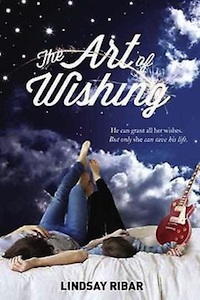How many supernatural love stories can there be out in the YA world? Boy meets girl, girl meets vampire, boy meets witch who can control the weather, girl must choose between Loch Ness Monster and Bigfoot? Okay, so I made that last one up. But the field of young adult fiction has been combining all kinds of supernatural and human mash-ups in an attempt to find the ultimate in teen heart-string pullers. Very few, however, bring young love to an audience with such quirky humor and believability as The Art of Wishing, a love story between a girl and her genie.
Forget what might come to mind when you think of genies, there’s no lamps and baggy pants or Disney montage musical numbers here. Lindsay Ribar’s debut novel brings us the story of Margo, a young woman struggling to deal with her parents’ recent re-marriage. When she finds a ring that holds a genie, Margo is given the chance to have three wishes. Standard deal, right? Only this time, the genie she’s dealing with isn’t big, blue, and mouthy. Instead he’s an earnest, thoughtful-looking photographer named Oliver who becomes her unexpected confidante and love interest. Together the two have to navigate the problems of high school theater club drama, homicidal genies and teenage interpersonal relationships, all while Margo tries to tap into her inner musician to become the singer/songwriter she’s meant to be. Toss in some problems with Mom and Dad, and The Art of Wishing has everything a book needs to be a relatable coming-of-age story.
Considering the fact that this is a YA supernatural romance novel, I’d have to say that the strongest part about Ribar’s book isn’t the romance or the supernatural elements. The Art of Wishing stands head and shoulders above competition because of its main character Margo. Ribar brings us a heroine who is quick-witted, amusing to read, and honest. Her problems aren’t overblown or grandiose, or full of angst-ridden self-doubting diatribes on the unfairness of the world. Instead, Margo spends the book battling her self-confidence issues, growing exponentially as a character through her introduction to Oliver and her three wishes. Margo’s internal voice is strong and Ribar’s dialogue makes her sound utterly relatable, vulnerable, and open to readers while still being a decisive, strong-willed heroine. Margo stands as an example of a female protagonist who is flawed but intelligent and introspective yet fallible in a way that doesn’t make us want to cringe. When she acts, it is with the sureness of a young woman who knows what she wants and we are right on board with her every step of the way.
But we can’t avoid talking about the romance, can we? Does The Art of Wishing deliver on the supernatural romance front? It certainly does, but not in the way you’d think. There’s little by way of dreamy, over-the-top descriptions or love-lorn long monologues about unnaturally beautiful loves that will transcend time. Despite Oliver being an ancient genie falling for a high school girl, the relationship between the two feels natural in its evolution. Oliver and Margo are an adorable teenage couple right off the bat, going through the growing pains of getting to know one another in what are perhaps the strangest circumstances. The book takes us through the awkward first emotions of their relationship with an earnestness that almost feels too close sometimes.
The book also tackles the potential creepiness of the genie/master dynamic well, as Ribar skirts the questions of meaningful choice carefully by exploring the boundaries of Oliver’s captivity in detail. The relationship really turns interesting when Margo realizes that Oliver can transform himself to suit his master’s wants and questions the validity of their connection, an issue anyone can empathize with when they’ve been in a relationship. Is this person changing just to be with me? Well, in Oliver’s case the answer might literally be yes and the two explore the problem maturely, all the while dealing with a supernatural adversary. It’s that maturity in Ribar’s characters that makes The Art of Wishing truly engaging.
If there is a weakness in the book, it would be that these interpersonal relationship questions greatly overshadow anything about the supernatural aspect of the book. Oliver’s genie-ness and the story of his kind’s history falls short and seems just scenery for the romance, as does the rivalry with Oliver’s nemesis. Ribar misses an opportunity for expanding Oliver’s history with more in-depth narrative and the result leaves the potentially rich genie history as window dressing to the boy-meets-girl aspects of the book. Still, the strength of that relationship makes up for any shortcomings and roots the story deeply in Margo’s transformation throughout the adventure.
In the end, read The Art of Wishing if you’re looking for a girl’s coming of age story, not for supernatural thrills and you won’t be disappointed. I’m looking forward to more offerings from Ribar in the future.
The Art of Wishing is out now from Dial.
Shoshana Kessock is a comics fan, photographer, game developer, LARPer and all around geek girl. She’s the creator of Phoenix Outlaw Productions and ReImaginedReality.com.










